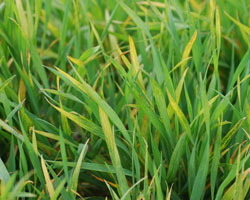Choosing the Right Variety for Next Year’s Wheat Crop
A new K-State Research and Extension report shows how wheat varieties fared in combatting diseases and insects this year.

July 28, 2015
MANHATTAN, Kan. – Wheat producers know that diseases and insects can considerably decrease yields and economic returns. K-State Research and Extension plant pathologist Erick De Wolf said 2015 was a big year for diseases—including widespread stripe rust, leaf rust and head scab—affecting the Kansas wheat crop.
Each year, De Wolf and other Kansas State University experts in plant pathology and entomology compile a report that rates major hard red winter wheat and hard white winter wheat varieties on how resistant they are to common diseases and pests. Wheat growers can use this report in the next few weeks and months when selecting varieties to grow for next year’s crop.
To rate these varieties, De Wolf travels Kansas surveying them for diseases at 35 to 40 locations, including those involved in county demonstrations, wheat plot tours and variety performance tests. Additional data to form the ratings comes from his colleagues at K-State and the U.S. Department of Agriculture, who expose varieties to different diseases in research nurseries to assess performance.
“Wherever possible, we’re evaluating for stripe rust, leaf rust and tan spot, among other diseases,” De Wolf said. “We capture data throughout the state, beginning southeast to northwest.”
Each variety is rated as a single number for each disease or insect on a scale from 1 to 9, with the higher number meaning higher susceptibility. Therefore, lower numbers are desired.
In the report, producers can find ratings for both new and long-term varieties, such as Jagger 2137 and Karl 92.
“As we add new varieties to the list, we’re always looking for information to try to fill in the gaps from the initial information when the variety was released,” De Wolf explained. “Is that still accurate? Is that representative of what we see in more locations and acres? With more experience with (each new variety), we can update that information.”
Another reason for yearly ratings, De Wolf said, is due to natural changes in the pathogen population and how the varieties react. Stripe rust, leaf rust and stem rust ratings tend to be more volatile and can show extreme differences from year to year. Fortunately, the ratings to stripe rust were relatively stable this year, with just a few exceptions on newer varieties.
De Wolf added that while stripe rust was the No. 1 disease priority statewide for 2015, the Hessian fly was the most common pest issue for the year.
Producers can access the “Wheat Variety Disease and Insect Ratings 2015” publication online through the K-State Research and Extension Bookstore or at their local extension office.
-30-
Story by:
Katie Allen
K-State Research and Extension
katielynn@ksu.edu
785-532-1162
For more information:
Erick De Wolf – dewolf1@ksu.edu or 785-532-3968
